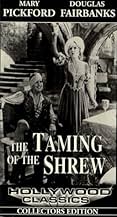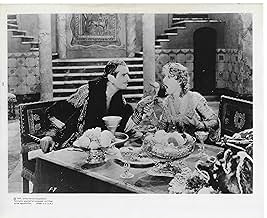Adicionar um enredo no seu idiomaIn sixteenth century Padua, Hortensio loves Bianca, the youngest daughter of Baptista. But Baptista will not allow the two to get married until his eldest daughter, the extremely headstrong ... Ler tudoIn sixteenth century Padua, Hortensio loves Bianca, the youngest daughter of Baptista. But Baptista will not allow the two to get married until his eldest daughter, the extremely headstrong Katherine, is betrothed. This task seems impossible because of Katherine's shrewish demean... Ler tudoIn sixteenth century Padua, Hortensio loves Bianca, the youngest daughter of Baptista. But Baptista will not allow the two to get married until his eldest daughter, the extremely headstrong Katherine, is betrothed. This task seems impossible because of Katherine's shrewish demeanor. They believe their prayers have been answered with the arrival from Verona of the lust... Ler tudo
- Direção
- Roteiristas
- Artistas
- Prêmios
- 2 vitórias no total
- Servant
- (não creditado)
- Little Boy
- (não creditado)
- Little Girl
- (não creditado)
- Servant
- (não creditado)
- Direção
- Roteiristas
- Elenco e equipe completos
- Produção, bilheteria e muito mais no IMDbPro
Avaliações em destaque
Petruchio really is quite a suitable role for Fairbanks, and his buoyant confidence works well. His portrayal seems to be pretty close to the kind of character that Shakespeare intended. The role of Katherine doesn't give Pickford a chance to use her greatest strengths. She does project good energy, and has plenty of charm when it is called for, but at times her portrayal doesn't seem to fit the original conception of the character, and the role definitely did not give Mary the chance to display her wide range of talents with more subtle material.
The story is a rather loose, jaunty adaptation of the original, and there would be little point in making detailed comparisons. As a movie, most of it works all right aside from the occasional instances of awkwardly-paced dialogue and the like that are characteristic of so many films of the early sound era. Fairbanks does help make some of these moments less noticeable with his obvious good humor. There are certainly a number of obvious ways in which it could have been better, and it's fair to point them out. Yet it still has enough of the classic story, plus enough of its own energy, to make it worth seeing as long as you know what to expect.
As to the unfaithfulness to the text, the film has Kate overhearing Petruchio's plan to tame her and she then turns the tables on him. Though not Shakespeare, this works in the film. As to faults, I did think Grumio's sneezing fit overlong and the frequent closeups of his reactions throughout the film were annoying. I suppose his part was built up to provide additional comedy, which was unnecessary. Aside from Petruchio's tedious apple core munching, which was Fairbank's idea, much of Shakespeare's wittiest dialog and jokes are intact and just as funny today as they were 400 years ago.
Of the two stars, Doug is clearly the better. Director Sam Taylor moulds the roles around the performer, and not the other way around, which was unwise but understandable. The Fairbanks image suits Petruchio better than Pickford's suits Kate. (At her best Pickford is magnificent, at her worst embarrassing. She herself called it one of her worst performances, and there is no reason to doubt her.)
For an early talkie it has remarkable fluidity, though it is only the 1966 re-edited version that is available today. (When I approached the Mary Pickford Company in 1992 to see if I could arrange a screening of the 1929 release print - which was longer and had a different score - I was politely but firmly told to go away!)
Two points of interest. This film was emphatically not the box office flop that many writers have claimed; it returned a healthy profit on its first release. And the credit line "by William Shakespeare, with additional dialogue by Sam Taylor" is pure myth. It appears not in the script, the 1966 nor in the 1929 (I have it on reliable authority) prints of the film. Where do these things get started?
The movie was a vehicle for real-life husband and wife Douglas Fairbanks and Mary Pickford, he in his first talkie, she in her second. Given the state that their marriage had degenerated into by this point, the storminess between the two of them probably wasn't that far from the truth. They both act well it has to be said, hamming it up magnificently in a manner drawing upon their experience both in stage and silent cinema, and which you can only really get away with in the context of this play's comical theatricality.
The director is Sam Taylor, a man with a background in comedy, who helmed the finest Harold Lloyd movies during the silent era. The Taming of the Shrew sees him returning to his roots, staging the verbal comedy as broad slapstick. Taylor is a master of the pull-back-and-reveal gag, making us think one thing then punch-lining us with another. In adapting the play, he pares down Shakespeare's dialogue, and reduces it for the most part to a poetic backdrop, allowing the comic vignettes to tell the story. This is quite something, because this style of physical comedy more or less died out when the talkies came along, but here Sam Taylor is showing a way it could have continued.
But what is also intriguingly good about this version of The Taming of the Shrew is its sly subversion of Shakespeare's misogyny. The bard's lines remain what they are, but the action in between them is enough to tweak their message. Pickford is brilliantly sarcastic for Katherine's final speech, and as Fairbanks sits beside her with a large bandage on his head, it becomes clear who's taming whom.
Você sabia?
- CuriosidadesIn her later years, Mary Pickford stated that working on the film was the worst experience of her life, although she also acknowledged that Douglas Fairbanks's performance was one of his best.
- Versões alternativasAfter many years out of circulation, the film was re-released in 1966 in a new cut supervised by Mary Pickford herself. New sound effects were added throughout, much of the voice dubbing was enhanced with newly available technology, and seven minutes were cut from the initial print. This re-released version is the only version now available on DVD or VHS.
- ConexõesFeatured in Mary Pickford: A Life on Film (1997)
Principais escolhas
Detalhes
- Data de lançamento
- País de origem
- Idioma
- Também conhecido como
- The Taming of the Shrew
- Locações de filme
- Empresas de produção
- Consulte mais créditos da empresa na IMDbPro
Bilheteria
- Orçamento
- US$ 504.000 (estimativa)
- Tempo de duração1 hora 3 minutos
- Cor
Contribua para esta página






























